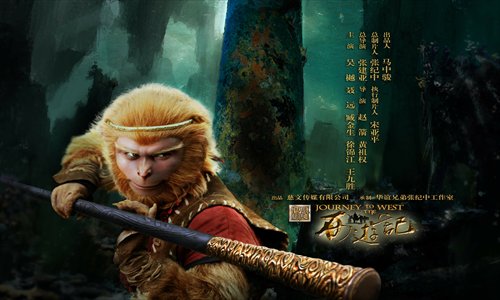
A poster for the TV series Photo:CFP
Creating new televised versions of the Four Major Classical Novels in China was always going to be a hard nut to crack, particularly as fondly remembered earlier television adaptations have become so synonymous with these famous stories.
And the latest attempt, a new version of Journey to the West (the broadcasting of the 60-episode production finished last week) hasn't entirely escaped criticism and unfavorable comparisons.
Poor design, wooden performances, unconvincing special effects and anachronistic dialogue were among the many complaints audiences have leveled at this new production. And yet despite the gripes, the program has attracted a growing number of viewers during its run, and over the past month has been one of the country's top-rated shows.
Wild about animals
The producers have spent lavishly. The two costume heads for Monkey King and Pigsy alone cost a barely credible 5 million yuan ($793,085).
"But it's a pity that the supposedly omnipotent Monkey King looks as if he is tortured by facial paralysis in this strange mask," said Yu Xin, a member of the Shanghai Association of Film Critics. "The nimble and smart Monkey King as performed by Liu Xiao Ling Tong in the 1986 Television version is nowhere to be seen in this new incarnation."
Drawing comparisons between the new Monkey King and a character from the hit film Avatar, people have been jokingly asking why the director has opted for a costume that makes Pigsy look like a real boar.
In fact, so lifelike are the animal masks and makeup that some netizens have taken to nicknaming the show "wild animal world," to almost universal approval.
The image of the new Pigsy is certainly ugly and terrifying, and director Zhang Jizhong has commented that this veracity was precisely his intention. He even wanted the character to walk around on curved hind legs and trotters. "But it turned out that actor couldn't move around easily after putting on these props. And we couldn't even complete a few fighting scenes in a day. So we gave up on the legs," said Zhang.
Mu Sen, another film critic, said that he applauded the new ways in presenting classical figures, but that people should not forget the real essence of these works of art. "Journey to the West is a historic classic rather than simply a piece of mythology. Its beauty lies in its romanticism, more than its realism," he said.
The critic, however, praised the new characterization of Monk Xuanzang. In the 1986 version, the monk would have been ravaged by a tiger before meeting his three disciples if it wasn't for a hunter who came to his rescue. This time around he has a swarthy complexion and a personality that is keen-witted and capable. Critics have commented that this personality better reflects Monk Xuanzang as he was originally imagined by Wu Cheng'en, who wrote the story back in the 16th century.
Pricy effects
At a total cost of 140 million yuan, a major part of the production was spent on special effects, and this is how the series has been largely promoted. It's even been reported that specialists from Hollywood were hired to work on the show.
And yet many viewers remained unimpressed. They described a sky that looked like paper, clouds that didn't move, and a palace in heaven that resembled nothing more than a 3-D version of the nightscape featured on the desktop of Apple computers.
"To be fair, the special effects in this version are much better than those in previous television productions," said Yu. But the problem is that given the current environment in which domestic audiences have easy access to Hollywood blockbusters and American dramas, our omnipotent Monkey King seems no more amazing than those high school students in the television series Heroes who suddenly discover they have superhuman powers.
The scenarist of the new Journey to the West, Gao Dayong, said that while special effects technology has vastly improved in recent years, it has been matched by an equally large jump in audience expectations. "If our techniques are 10 times better than they were in the 1980s, then audiences' expectations have simultaneously been raised 100 times."
Generally speaking, professional film critics say the new production is definitely not as bad as some viewers have painted it.
Faithful to the original
"Basically, it has followed the content in the original work," said Yu. "In fact much of the dialogue is lifted directly from the novel. But the question that needs to be asked is why we are remaking this work in the first place? What kind of contemporary cultural importance does this work actually have? And if no satisfactory answers are forthcoming, this production can only be regarded as a way for its producers to make money."
Mu also called for caution when attempts are made to remake or adapt classic stories. "Let's imagine Journey to the West as an ancient bottle. It is fine if we fill it with new wine to cater to modern people's aesthetic demands. But don't forget that this ancient bottle is a fragile cultural relic, and filling it with new wine could destroy it," said Mu.
The critic added that in the current television series market, quantity is emphasized over quality. Considering the time involved, if a production team cannot come up with a valid reason to create a new adaptation, maybe they should re-think such a project, according to Mu.

Copyright ©1999-2011 Chinanews.com. All rights reserved.
Reproduction in whole or in part without permission is prohibited.